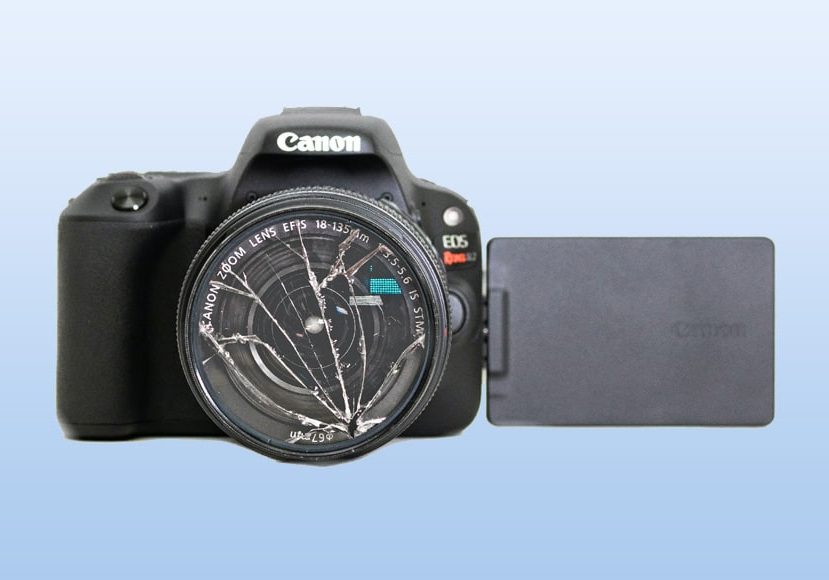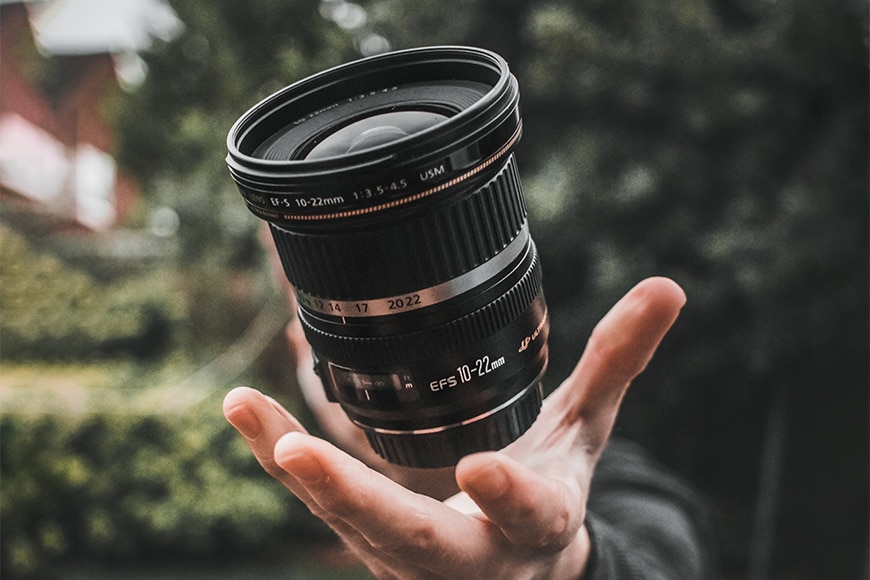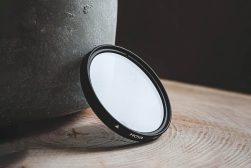
Camera Lens Repair Guide: Testing, Fixing & Restoring
Ever wondered if you can fix a broken camera lens? Discover the various options to restore or repair your camera lenses and the best places to do it.
Learn | Photography Guides | By Ana Mireles
Ever wondered if you can fix a broken camera lens?
Cameras lenses are notoriously fragile, so it’s no surprise that camera lens repair issues are common for photographers.
You may also have encountered a broken lens when buying used camera lenses.
Fixing a broken camera lens yourself can be done, but it’s not recommended – you may end up doing more damage, and you’ll usually need specialist equipment to do the repair properly.
In this guide, we’ll look at the various options to restore or repair your camera lenses.
(You’ll also learn when it’s time to search for a replacement!)
How Do You Know if a Camera Lens is Damaged?

If you feel like something is wrong with your lens, start by researching online.
Go to the original website or the press release to look for the sample photos that manufacturers usually publish.
You should check any forums where your lens is discussed. This will give you a point of comparison to see if the pictures you’re getting match the quality of the ones other people are getting with the same lens.
You can also visit a local photography store and ask to see the lens to make some trial photos there, to see if that lens behaves in the same way as the one you have at home.
If you notice that something is off, try making some of the following tests.
How do I test my camera lens?
Before you start with the tests, check for any physical damage. Turn the zoom and the focusing rings and see if everything moves smoothly, and you don’t hear any weird sounds.
Also, check the front element of the lens and look towards the inside shining light from different angles to search for any scratches on the glass elements.
Then, look at the sealing of the lens and the lens mount. Look for scratches on the lens’ body, too – be thorough.
Now it’s time to put your lens on the camera and do some test shots. Start by checking the autofocus to see if there aren’t any issues.
On the photos, look for any uneven focus, whether the image is sharp enough or if there’s any excessive chromatic aberration and vignetting.
You can compare the photos you took with the ones published online to see if your lens delivers the same quality.
Then, do a sharpness test – make sure you use a tripod to avoid any camera shake. You can download sharpness tests from the web to be more accurate, but you can also photograph something flat and parallel to the camera. In the video above, Stephan Malloch suggests a brick wall.
Put the lens in manual focusing mode, then focus and defocus your subject to see if the centre stays in the centre and that both sides of the image focus and defocus simultaneously. Then check if everything is equally sharp across the frame.
Then, do a focus accuracy test to see if it’s back or forward focusing – you can do this with a calibration chart. Many lenses can be fine-tuned on your own. Try using the lens software when available – otherwise, send it back for calibration.
Note that this isn’t a perfect technique, it might not detect all issues, or it might not work on all lenses. If you feel disappointed with the photos your lens is delivering, don’t hesitate to take it to a specialist or reach out to customer support.
How Much Do You REALLY Know About Photography?! 🤔
Test your photography knowledge with this quick quiz!
See how much you really know about photography...

How long do camera lenses last?
It depends on the lens and the use and maintenance that you give it – on average; it should last more than five years.
Just to give you an example, I still have a Canon lens I had for my film camera from 20 years ago and use it with my digital cropped sensor EOS.
Suppose you make a significant investment in a lens. In that case, it’s better to buy the extended warranty and get insurance for your gear – if available, find one that covers the repairing of the lens or the replacement if the damage isn’t fixable.
Can Camera Lenses Be Repaired?

Most damages caused on lenses can be repaired – it might cost you a lot of money, though. It all depends on the type of damage.
Camera lenses can have a mechanical problem if the zoom isn’t working correctly or the aperture ring isn’t turning.
Other issues come from the software – you can identify this when lenses aren’t delivering a sharp image or aren’t responding well to the autofocus settings.
When you drop your lens, the glass elements inside can suffer damage. They can get misaligned, scratched or even break.
Finally, it can get water damage when the sealing has worn off, or there might be damage to the lens mount. This can create problems if you store or use your gear in humid places.
We’ll go through some of the most common repairs in the following sections of this article.
How do I Fix a Broken Camera Lens?
While the external parts of the lens are somewhat easy to fix, the internal elements – especially the moving parts often can’t be fixed. In some cases, the repairs are possible, but the cost is higher than a new lens.
First, you need to determine what is the problem. If you’re receiving an error message, the lens is most likely having an issue with the software. Try updating the firmware to see if that fixes it. Otherwise, it might be that the software identifies a mechanical error.
If the problem is that you’re not getting sharp enough images, your lens might just need a calibration. There are different tools to check it, and in many cases, you can adjust it inside the camera or by using the lens software.
You might be dealing with scratches on the front element if you see halos or artefacts after dropping your lens.
If you don’t know what’s going on – you can send the lens for an inspection by a professional. In some cases, this is free of charge.
They’ll tell you what’s going on and whether or not it’s fixable. They’ll also give you an estimate for their services if you want it to be repaired by them.
This is, of course, the best choice. However, if it doesn’t fit your budget or it’s something minor that you think you can solve by yourself – you’ll find some advice later in the article.
Remember also that your lens may just need a good clean – see how to clean a camera lens.
How do I Restore My Camera Lens?
Some people think that a damaged lens means that you have to buy a new one. Fortunately, this isn’t always the case. Some damages don’t affect the resulting images – at least not enough to go to the trouble (and cost) of fixing them.
Other times, you can solve the problem yourself. Of course, you need to be very careful and be aware that reaching out to a professional will always be the best choice to avoid any risk of doing more damage than good.
(You can also get a lens cleaning kit and have a go at getting rid of any minor stains or marks yourself.)
Next, you’ll find some common lens problems that can be fixed.
How to Fix a Scratch on a Camera Lens
If you have a scratch on the front element, you should check if it’s causing any problems with your image. Make a few test shots on different light conditions and look for halos or other weird artifacts. It might be that the scratch doesn’t impact the final photo.
If it does, you can use a scratch-removing wax – the kind you would use on a car, a wax cleaner, and a small polisher drill. Just put some wax and buff the front element for a few minutes – this usually works for superficial scratches.
It also works when the damage is in the coating instead of the glass. Keep in mind that you might be removing the coating on the front element of the lens using this technique (as shown in the video) – which can cause other problems later on.
If the scratch is not coming off this way, you might need to replace the front element. I don’t recommend you do this on your own – even if it’s more expensive, it might be better to send it off to a professional shop.
However, if you feel like taking the risk – look for YouTube tutorials for the specific lens because each one will have a different design.
Replace the lens mount
Unfortunately, when you accidentally drop your lens, the lens mount is one of the pieces that are most likely to break.
The good news is that the lens mount is more straightforward to replace than a front element, and the replacement parts are usually affordable.
Again, if you want to do this yourself, you’ll need to search for the instructions for your lens or brand. Typically, you’ll just have to unscrew the damaged part and screw back the new one.
The trickiest part is to keep the contact plate in place because that’s how the camera and the lens ‘communicate’.
Where Should I Take My Camera Lens to be Repaired?
When something is wrong with your camera lens, you can go directly to the manufacturer or go to a third-party repair shop which is slightly cheaper. However, be careful and make sure the repair centre is trustworthy and, better yet, if it’s authorised by the manufacturer.
Each brand usually has local representatives – in most cases, you’ll find this information in the manual. If not, you can always go online. Here are a few websites that can help:
- KEH CAMERA is a US-based store that resells used gear and offers an excellent repair service. They’re based in Atlanta, but you can mail them your lens and receive an estimate if the job is more complex than the average or special parts are needed. If the repair fits the average needs, KEH CAMERA’s prices for a non-professional fixed focal lens under 200mm is USD$180, while a professional one over 20mm is USD$320. For zoom lenses, the price is USD$320 and for teleconverters is USD$115. To repair a medium format lens, you’ll need USD$255 for a fixed focal length, and USD$280 for zoom lenses – for large format lenses is USD$180.
- Canon US: The inspection is free, and then you’ll receive an estimate if they find something wrong. If you only want maintenance service, the cost is USD$59.
- Canon Europe: Here, you’ll find general instructions on what to do if something is wrong with your camera lens. There’s also a country selector to get local support.
- Canon Australia: Find the type of support you need and fill in the form if you need to submit your equipment.
- Nikon US: You can find local help if there’s a Nikon store close to you or book a service if you need to send the lens.
- Nikon Asia: Here you can enquire about maintenance and repair services.
- Nikon Europe: You can be redirected to your local Canon website for further information from this directory.
- Sony UK: Here, you’ll find a diagnostic form, a repair shop locator, a guide to preparing your gear for repair, and anything else you need for your Sony lens.
- Sony Asia: On this website, you can get in touch with customer support, use the repair centre locator, and track a repair status.
- Olympus: Before you send in your lens, you can find the policies and procedures and a troubleshooting guide here. If you still need professional service, there’s also the request submission form or the contact information if you prefer to call them.
- Sigma: Find help and solutions for your Sigma lenses here, or contact them for inspection and services.
- Tamron Europe: Based in Cologne.
- Tamron US: Here, you’ll find the contact to customer service, and you can download the repair request form needed to send in your lens for service.
Final Words
I hope you find these tips helpful – but remember that it’s always best to prevent damage. So, use a UV filter to protect the front element, get a padded bag, and send your lens for maintenance service every one or two years (maybe more if you use it professionally).
Also, keep in mind that a lens is a delicate piece of gear with multiple glass elements and moving parts – that’s why it’s best to have it repaired by a professional if it’s within your means.

Check out these 8 essential tools to help you succeed as a professional photographer.
Includes limited-time discounts.













